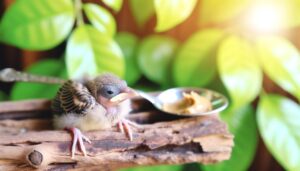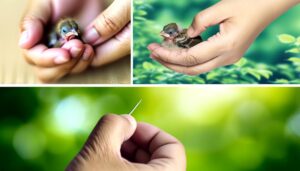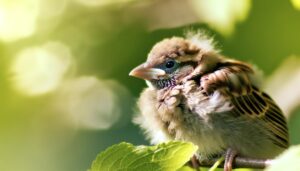How Much Does a Baby Sparrow Weigh: A Step-by-Step Guide
A baby sparrow typically weighs between 1.5 and 2.5 grams at birth. As they grow, hatchlings can range from 1.5 to 3 grams, while nestlings weigh 3 to 6 grams.
By the fledgling stage, they reach about 15 to 25 grams. Monitoring their weight is vital for evaluating health and nutrition.
Rapid weight changes can indicate health issues, so using a digital scale for precise measurements is necessary. Environmental factors like food availability and habitat quality also impact their growth.
Understanding these details can help you appreciate the complexities of their development and the significance of conservation efforts.
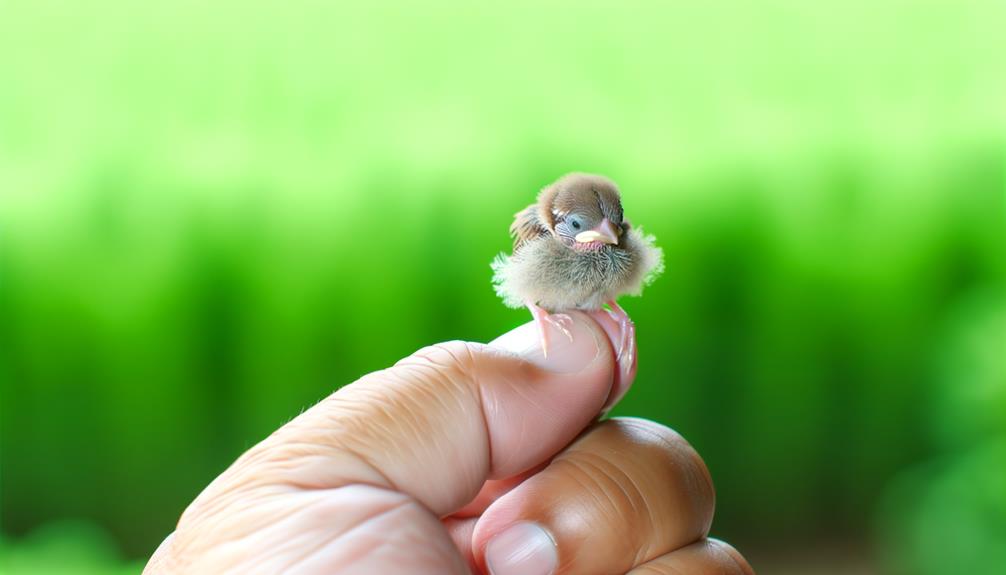
Key Takeaways
- A baby sparrow's average weight ranges from 1.5 to 2.5 grams.
- Hatchlings weigh between 1.5 to 3 grams.
- Nestlings have a weight range of 3 to 6 grams.
- Fledglings typically weigh between 15 to 25 grams.
- Weight monitoring is crucial for assessing a baby sparrow's health.
Average Weight
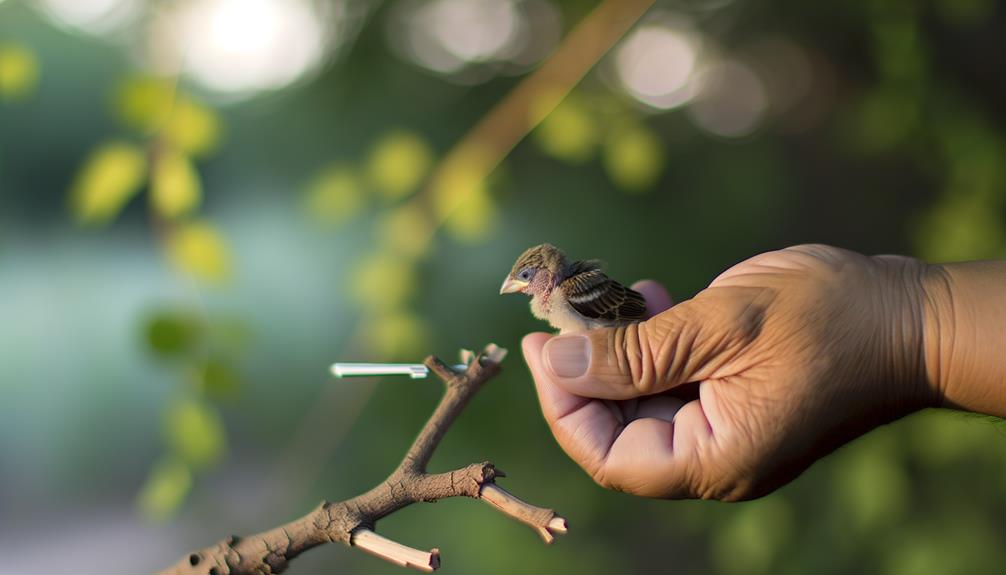
A baby sparrow's average weight ranges from 1.5 to 2.5 grams, depending on its species and age. You'll find that these tiny creatures are incredibly light, almost like holding a small paperclip. It's important to be gentle when handling them.
Weighing them accurately requires a precise digital scale. By knowing their weight, you can make sure they're getting the right amount of food, which is vital for their survival. Serving these little birds means monitoring their health closely.
You'll need to be attentive to any changes in their weight, as rapid fluctuations could indicate health issues. Remember, every gram matters when it comes to the well-being of a baby sparrow.
Growth Stages
Observing the growth stages of a baby sparrow reveals critical milestones in their development, from hatching to fledging. You'll notice significant changes in their physical and behavioral characteristics. Initially, they are altricial—naked and helpless, relying entirely on parental care. By Day 3, they start developing feathers, which continue to grow until they fledge around Day 14.
Here's a simplified timeline:
| Day | Physical Change | Behavioral Change |
|---|---|---|
| 1 | Naked, eyes closed | Begging for food |
| 3 | Feather growth begins | More responsive to parents |
| 7 | Eyes open, feathers grow | Attempting to stand |
| 14 | Fully feathered | Ready to fledge |
Understanding these stages helps you provide the appropriate care and nutrition they need.
Hatchling Weight
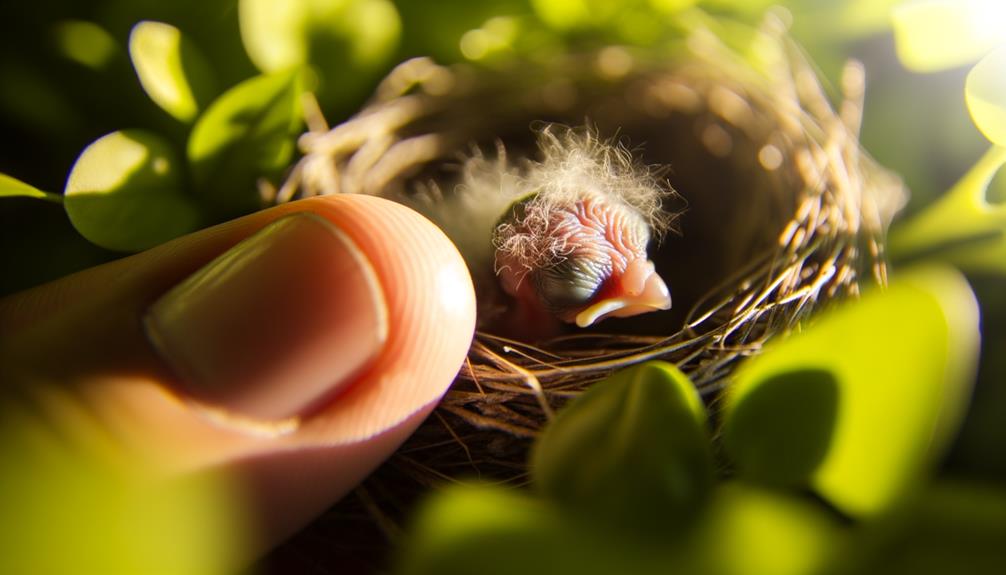
You should start by understanding that a newborn sparrow typically weighs between 1.5 to 3 grams.
Monitoring their growth milestones, such as doubling their weight within the first week, is essential.
Ensuring proper nutrition directly impacts these early developmental stages, influencing their overall health and survival rates.
Initial Weight Range
Newly hatched sparrows typically weigh between 1.5 to 2 grams, reflecting their extremely delicate and fragile state. At this stage, they're highly vulnerable and require careful care. Understanding their initial weight is essential for guaranteeing proper nourishment and growth.
You should be aware of several key factors:
- Temperature Regulation: Newborn sparrows can't regulate their body temperature and need a warm environment.
- Nutrient Needs: They require frequent feeding with nutrient-rich food to support their rapid development.
- Health Monitoring: Regularly check their weight to guarantee they're gaining steadily and not showing signs of illness.
Growth Milestones
Typically, hatchling sparrows experience rapid weight gain, doubling or even tripling their initial weight within the first week.
You'll notice that these tiny birds, weighing just about 1.5 grams at hatching, can reach up to 4.5 grams by day seven.
This significant growth is vital for their development, ensuring they've the strength to open their eyes, start feathering, and eventually fledge.
Monitoring their weight daily is essential, as it's a clear indicator of their overall health.
Any deviations from expected growth patterns can signal potential issues that may need your intervention.
Nutritional Impact
The nutritional intake of a hatchling sparrow directly impacts its weight gain and overall health during the essential first week of life. Adequate nutrition guarantees proper development and survival.
You should focus on providing a balanced diet rich in:
- Protein: Essential for muscle and tissue growth.
- Fats: Important for energy and cellular function.
- Vitamins and Minerals: Essential for immune system strength and bone development.
Nestling Weight
Nestling weight in baby sparrows serves as a significant indicator of their overall health and development. When you monitor these young birds, you're looking for weights between 3 to 6 grams within the first few days post-hatching.
Consistent weight gain is vital; it reflects proper feeding and nutrient absorption. If you notice a nestling isn't gaining weight as expected, it could signal underlying issues like malnutrition or illness.
Regularly weighing nestlings helps you make sure they're thriving and can prompt timely intervention if needed. Monitoring weight also aids in understanding growth patterns, which is important for any conservation or rehabilitation efforts you're involved in.
Your careful attention to these details can have a meaningful impact on their survival and well-being.
Fledgling Weight
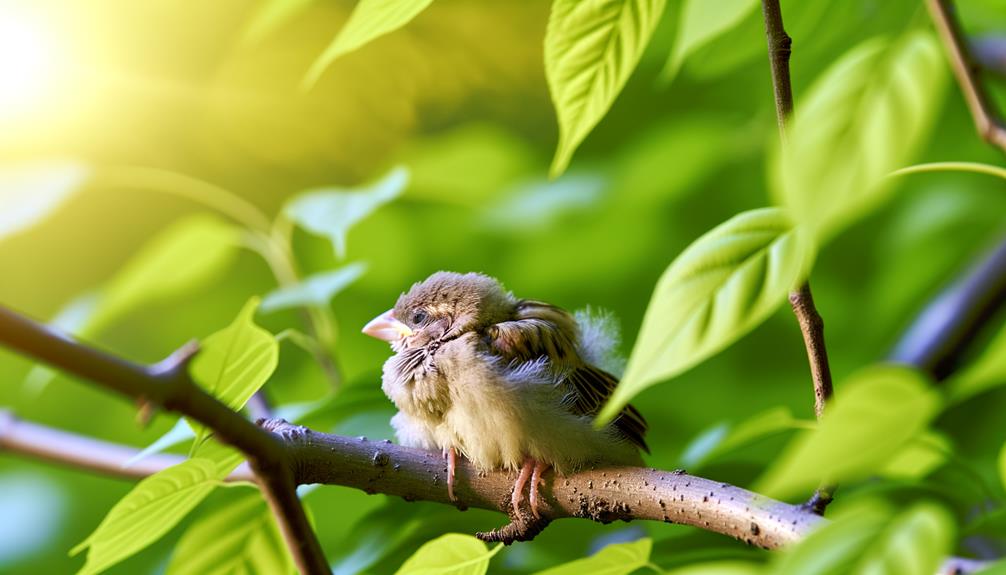
As fledglings start to venture out of the nest, their weight generally ranges from 15 to 25 grams, reflecting their shift from dependent nestlings to more independent young birds. This stage is critical for their development, as they begin to exercise their wings and practice essential survival skills.
You'll notice that fledglings exhibit a variety of behaviors and physical changes that support their growth.
- Increased Mobility: Fledglings start hopping and making short flights.
- Feather Development: Their plumage becomes more defined, aiding in flight.
- Diet Changes: They begin to eat a wider variety of foods, shifting from parental feeding to foraging.
Factors Affecting Weight
Various environmental and genetic factors greatly impact a baby sparrow's weight during its early stages of development. You'll find that elements such as temperature, habitat quality, and parental care play significant roles. Genetic predispositions also contribute to variations in weight. For instance, offspring from larger parents often weigh more at hatching.
| Factor | Influence on Weight |
|---|---|
| Temperature | Impacts metabolic rate |
| Habitat Quality | Availability of resources |
| Parental Care | Frequency of feedings |
Temperature can change a chick's metabolic rate, impacting growth. Habitat quality secures the availability of essential resources, like nesting materials and shelter. Finally, the frequency and attentiveness of parental care dictate how well-nourished and healthy the chicks are, directly impacting their weight. Understanding these factors can help you provide better care for these young birds.
Diet and Nutrition
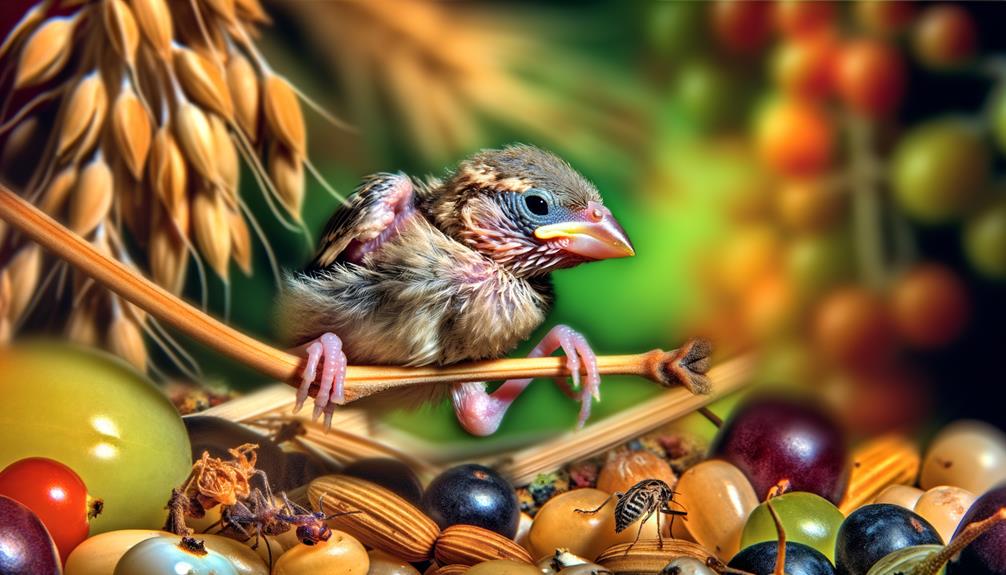
A balanced diet rich in proteins and fats is crucial for the optimal growth and development of baby sparrows. You need to make sure they receive a variety of nutrients to support their rapid growth and high energy needs.
Here's what a nutritious diet for baby sparrows should include:
- Insects and larvae: These provide high-quality proteins important for muscle development.
- Seeds and grains: These offer necessary fats and carbohydrates for energy.
- Fruits and vegetables: These supply essential vitamins and minerals for overall health.
Parental Care
You'll observe that parental care in sparrows greatly impacts the weight of their chicks. Parents often feed their young, ensuring they receive the necessary nutrients for best growth.
Additionally, they protect the nest from predators, promoting a safe environment for the chicks' developmental stages.
Feeding Frequency
Understanding the feeding frequency of baby sparrows is crucial as it directly impacts their growth rate, survival chances, and overall development. You need to know that parent sparrows feed their chicks every 15 to 20 minutes during daylight hours. This high frequency is essential to ensure the chicks get the necessary nutrients to thrive.
In your efforts to support these birds, consider:
- Monitoring Food Supply: Guarantee a consistent and ample supply of insects and seeds.
- Minimizing Disturbance: Keep the area around their nest quiet to reduce stress on the parents and chicks.
- Supporting Parents: Provide supplemental food sources to help parents meet the demanding feeding schedule.
Nest Protection
Ensuring the protection of the nest is essential for the well-being of baby sparrows, as it directly influences their safety and development. As a caretaker, you must focus on securing the nest from predators and environmental hazards. Both parents actively guard the nest, often choosing locations that provide natural disguise and elevation. They'll fiercely fend off intruders and even use distraction techniques to lure threats away.
| Factors | Protection Methods |
|---|---|
| Predators | Disguise, vigilance |
| Weather | Sheltered nest sites |
| Human Activity | Avoiding disturbed areas |
Developmental Stages
Observing the developmental stages of baby sparrows, you'll notice that parental care plays an important role in their growth and survival. Parents tirelessly feed their chicks, ensuring they receive essential nutrients for proper development.
They also keep the nest clean, removing waste to prevent infections. Additionally, they protect their young from predators and harsh weather conditions.
- Feeding: Parents provide a diet rich in insects and seeds to meet the chicks' nutritional needs.
- Hygiene: Regularly cleaning the nest helps avoid disease and promotes a healthy environment.
- Protection: Vigilant against threats, parents guard the nest to keep predators at bay.
Your understanding of these stages can help you support and care for baby sparrows more effectively.
Environmental Impact
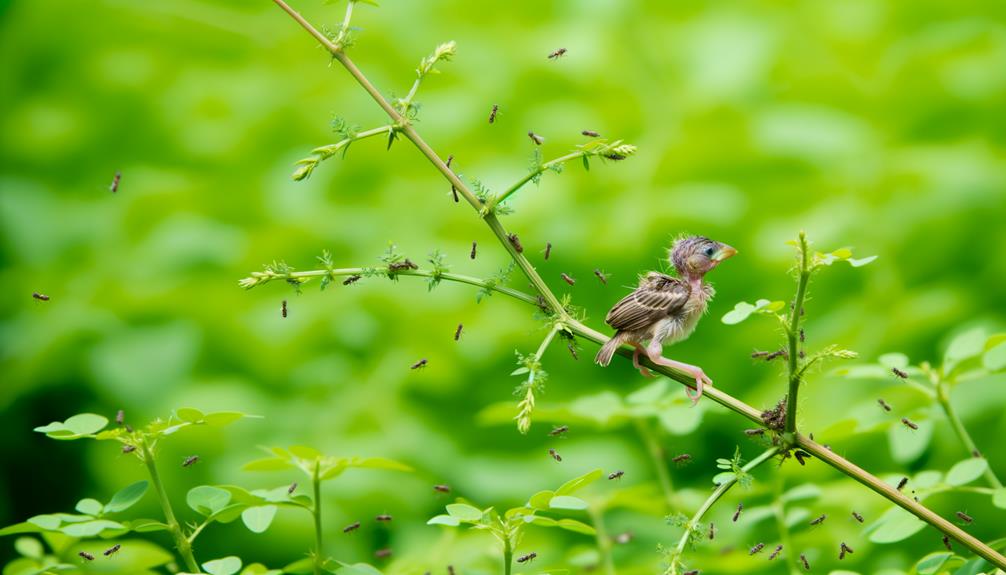
Environmental factors play an essential role in determining the weight and overall health of baby sparrows.
You'll find that food availability directly influences their growth. When parents have access to a rich supply of insects and seeds, nestlings receive adequate nutrition, leading to healthier weights. Conversely, poor food supply can stunt growth.
Temperature and weather conditions also impact their survival rates. Cold, wet conditions can increase energy needs, making it harder for baby sparrows to gain weight.
Additionally, pollution and habitat destruction can limit food sources and nesting sites, further challenging their development. Understanding these factors helps you take steps to create supportive environments, ensuring baby sparrows thrive and contribute to a balanced ecosystem.
Health Indicators
You should closely monitor weight and growth patterns in baby sparrows to assess their health.
These indicators can help you identify signs of malnourishment, such as stunted growth or weight loss.
Tracking these metrics is essential for ensuring proper development and well-being.
Weight and Growth Patterns
During the first few weeks of life, baby sparrows exhibit rapid weight gain, which serves as an essential indicator of their overall health and development. You'll notice that their weight can double or even triple within just a few days. Monitoring these changes is essential for ensuring they're growing properly.
Here are some key observations:
- Daily Weight Measurements: Weigh the baby sparrow at the same time each day to track growth consistently.
- Feather Development: As they gain weight, you'll also see feathers replacing down, indicating healthy growth.
- Behavioral Changes: Increased activity and stronger chirps often accompany weight gain, showing robust health.
Signs of Malnourishment
While monitoring the rapid growth of baby sparrows, it's equally important to recognize signs of malnourishment that may indicate underlying health issues. You should look for symptoms such as stunted growth, thin and fragile feathers, and a lack of energy.
Observe their eating habits; a malnourished baby sparrow might exhibit reduced appetite or difficulty swallowing. Also, check for physical indicators like a prominent keel bone or sunken eyes, which can indicate inadequate nutrition.
Regularly weighing the birds can help track their development and identify any deviations from expected growth patterns. Promptly addressing these signs guarantees the baby sparrows receive the necessary care, promoting their health and well-being, and ultimately serving their best interests.
Weighing Techniques
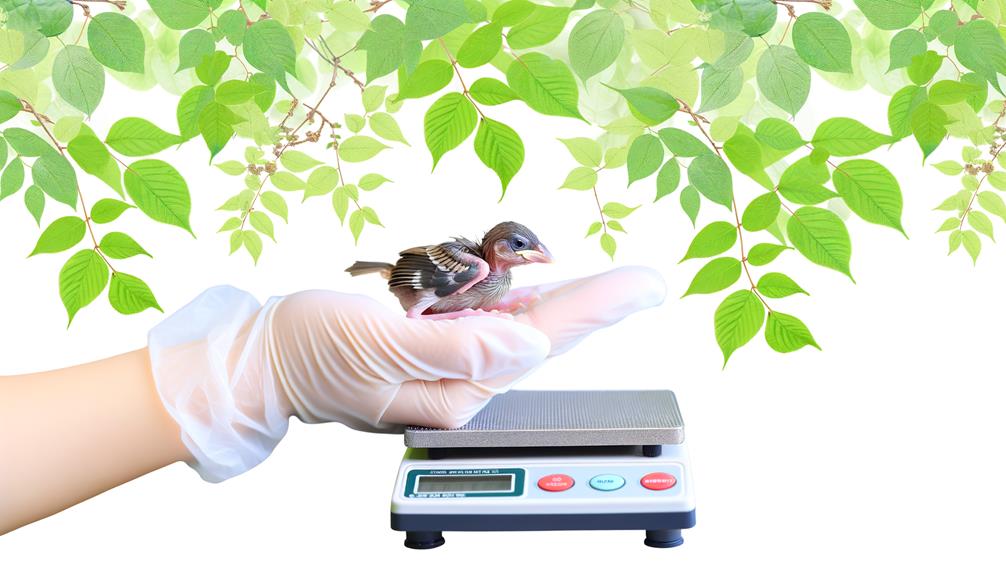
Accurately weighing a baby sparrow requires precise techniques and careful handling to secure the bird's safety and obtain reliable measurements. You'll need a digital scale with a resolution of at least 0.01 grams.
Gently place the sparrow in a lightweight container, taring the scale first to exclude the container's weight. Make sure the bird remains calm to avoid skewed readings.
To improve accuracy, consider these tips:
- Use a small, ventilated container: This keeps the bird secure without causing stress.
- Weigh at the same time daily: Birds' weights can fluctuate throughout the day.
- Minimize handling time: Reduces the risk of injury and stress to the sparrow.
Conservation Efforts
To guarantee the preservation of baby sparrows, conservation efforts focus on habitat restoration, predator control, and public education.
You can help by supporting initiatives that plant native vegetation, creating ideal nesting environments. In addition, control of invasive species like feral cats and certain birds reduces predation risks.
Public education plays an essential role in conservation; spreading awareness about the challenges sparrows face helps garner community support. Participate in local workshops or volunteer for bird monitoring projects.
Every effort counts, from installing birdhouses to advocating for pesticide-free environments. By actively engaging in these conservation steps, you'll make sure that baby sparrows not only survive but thrive, contributing to the health of our ecosystems.
Conclusion
In understanding a baby sparrow's weight, you've explored its growth stages, from the delicate hatchling to the resilient fledgling. Each stage reflects not just numerical weight but the bird's journey through life's early challenges.
By recognizing environmental impacts and health indicators, you gain a thorough view of their fragile beginnings. Employing precise weighing techniques guarantees accuracy, aiding conservation efforts.
Your newfound knowledge underscores the importance of protecting these small wonders as they progress through life's early thresholds.

